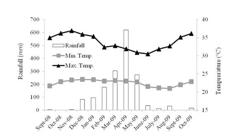ABSTRACT
Herb recovery was evaluated in degraded Caatinga sites protected from grazing and enriched with native trees, in Patos-PB state, Brazil. Treatments were randomized according to a block design with five treatments (no tree planting -T0 - or tree planting of three tree species in pure -T1=Poincianella pyramidalis, T2=Mimosa tenuiflora and T3=Cnidoscolus quercifolius - or mixed balanced stands -T4) and five replications of squared-144-m2 plots with 36 seedlings developing in planting holes enriched with manure and chemical fertilizers, arranged in a 2 m x 2 m grid. Data were collected from September 2008 to October 2009. After this period, natural tree regeneration was still not observed, and tree canopy covered 15 to 49% of the soil and did not affect herb growth and species composition. Initial and final herb cover were 16% and 100%, respectively. The number of dicot herbs increased from five, mainly two Sida species, to 13 species, monocots were represented by one species only (Aristida sp.), and quantity of herb forage reached 3 ton/ha (2:1, dicot:monocot). Adjacent overgrazed plots kept the initial low level of herb cover and species composition. Animal deferment during one year allowed the increase in soil cover and plant diversity in degraded Caatinga sites into which planted tree seedlings established successfully. This management practice could be implemented to avoid further environmental degradation and recover degraded areas.
Keywords:
tropical dry forest; Poincianella pyramidalis; Mimosa tenuiflora; Cnidoscolus quercifolius

 Thumbnail
Thumbnail
 Thumbnail
Thumbnail
 Thumbnail
Thumbnail


